
WGenInv
25.01.2019
Final dimension: A5
Fig.A
ATTENZIONE! Prima di usare la macchina, leggete e comprendete le istruzioni di sicurezza e le istruzioni d’uso fornite
WARNING! Before using the machine, read and understand the supplied safety instructions and operating instructions
1
Generatore inverter silenziato monofase a benzina
ISTRUZIONI DI SICUREZZA
Istruzioni originali
Silenced single phase inverter generator with petrol engine
SAFETY INSTRUCTIONS
Translation of the original instructions
9
2
10
6
11
3
5
8
7
4

- 2 -
i
AVVERTENZE DI SICUREZZA
ATTENZIONE! Leggere tutte le avvertenze
e tutte le istruzioni.
La mancata ottemperanza alle avvertenze e
alle istruzioni può dare luogo a scosse elet-
triche, incendi e/o lesioni serie.
La scrupolosa osservanza di queste avver-
tenze con l’utilizzo dei mezzi di protezione
individuale, minimizzano i rischi di incidente
ma non li eliminano completamente.
Utilizzate la macchina solo nei modi descritti
in queste istruzioni. Non utilizzatela per scopi
a cui non è destinata.
Queste istruzioni si riferiscono ad una mac-
china fabbricata in più versioni; leggete
attentamente le istruzioni ed applicatele alla
macchina in vostro possesso.
Conservare tutte le avvertenze e le istruzioni
per riferimenti futuri.
CARBURANTE: PERICOLO DI INCENDIO ED
ESPLOSIONE
ATTENZIONE! Spegnete sempre il motore
prima di ogni rifornimento. Il carburante e
i suoi vapori sono facilmente infiammabili,
fate attenzione a non versarlo su superfici
calde. Operate in un luogo ben ventilato, non
fumate, non avvicinate fiamme libere o oggetti
incandescenti.
Utilizzate occhiali e guanti protettivi. Non inge-
rite, non inalate i vapori emessi dal carburante
e tenetelo lontano dalla portata dei bambini.
Evitare il contatto con la pelle. In caso di
contatto con gli occhi lavare con abbondante
acqua e consultare un medico.
ATTENZIONE! Non utilizzate la macchina in
ambienti con pericolo di esplosione e/o incen-
dio, in locali chiusi, in presenza di liquidi, gas,
polveri, vapori, acidi ed elementi infiammabili
e/o esplosivi. Non utilizzate la macchina in
presenza di fonti incendianti quali fiamme
libere, sigarette, scintille ecc.
BATTERIA: PERICOLO DI INCENDIO ED ESPLO-
SIONE
ATTENZIONE! Per i gruppi elettrogeni dota-
ti di motore con avviamento elettrico, e quindi
di batteria, si rende necessario l’uso corretto
e l’efficienza della batteria stessa.
La batteria:
- produce gas esplosivi; usare estrema prudenza
per evitare tutti i pericoli di incendio e scoppio.
- contiene acido solforico (elettrolita); il
contatto con gli occhi e la pelle può causare
bruciature. Se l’elettrolita viene a contatto
con gli occhi, lavarsi con acqua per 15 minuti
e chiamare un medico. Tenere fuori dalla
portata dei bambini.
GAS DI SCARICO: PERICOLO DI AVVELENAMENTO
ATTENZIONE! Il motore emette un gas
velenoso, inodore e incolore contenente
monossido di carbonio: l’inalazione provoca
nausea, svenimento e morte.
ATTENZIONE! Non far funzionare la mac-
china in ambienti chiusi o poco ventilati. Non
respirare i gas di scarico. In caso di inalazione
rivolgersi subito ad un medico.
SUPERFICI CALDE: PERICOLO DI USTIONI
ATTENZIONE! Durante il funzionamento
alcune superfici esterne della macchina
possono raggiungere temperature elevate,
rimanendo tali anche per alcune ore dopo
l’arresto del motore. In particolare prestare
attenzione all’impianto di scarico dei gas e
alle parti calde del motore come la testata.
RISCHIO DI SCOSSA ELETTRICA O FOLGO-
RAZIONE
ATTENZIONE! L’energia elettrica è poten-
zialmente pericolosa e, se non opportuna-
mente utilizzata, produce scosse elettriche
o folgorazioni, provocando gravi lesioni o
morte, incendio e guasti alle apparecchiature
elettriche. Collegare la macchina ad un punto
di messa a terra.
ATTENZIONE! Mantenete i bambini, le
persone e gli animali lontane dal generatore.
ATTENZIONE! Collegare al generatore
apparecchiature elettriche (comprese spine
e cavi di prolunga) sempre efficienti.
Verificare sempre che la tensione dell’ap-
parecchiatura corrisponda a quella erogata
dal generatore. Nel caso sia utilizzata una
prolunga utilizzare un cavo per esterni isolato
in gomma conforme a IEC 245-4.
ATTENZIONE! E’ vietato e pericoloso colle-
gare la macchina e fornire energia elettrica ad

- 3 -
una rete elettrica fissa di edificio già collegata
ad una linea fornitrice di energia elettrica.
Solo ad un elettricista qualificato è consen-
tito eseguire questo tipo di collegamento, in
conformità alle leggi e alle norme elettriche
in vigore. Un collegamento sbagliato può
provocare un ritorno della corrente elettrica
erogata dal generatore nella rete pubblica
e provocare quindi scariche elettriche alle
persone che lavorano alla rete. Questo tipo di
collegamento può provocare un serio pericolo
di folgorazione e morte ed inoltre provocare
incendio o esplosione della macchina nonché
incendio della rete fissa dell’edificio.
ATTENZIONE! Il generatore è potenzial-
mente pericoloso se utilizzato in modo errato.
Non toccarlo con le mani bagnate, non utiliz-
zarlo in ambienti umidi o sotto la pioggia, la
neve e la nebbia.
ATTENZIONE! Controllate il cavo di alimen-
tazione del vostro apparecchio utilizzatore. Il
cavo di alimentazione e il cavo di prolunga
(se presente) devono essere controllati pe-
riodicamente e prima di ogni uso per vedere
se presentano segni di danneggiamento o di
invecchiamento. Se non risultassero in buone
condizioni scollegate immediatamente il cavo
e non usate l’apparecchio utilizzatore ma
fatelo riparare.
ATTENZIONE! Mantenete il cavo di alimen-
tazione del vostro apparecchio utilizzatore in
posizione sicura. Tenete il cavo di alimen-
tazione e il cavo di prolunga (se presente)
lontani del generatore, da superfici umide,
bagnate, oliate, con bordi taglienti, da fonti di
calore (compreso quelle del generatore), da
combustibili e da zone di transito veicolare e
pedonale.
RUMORE: PERICOLO DI DANNI ALL’UDITO
ATTENZIONE! Il livello di rumorosità ri-
portato nel foglio allegato, sono valori medi
di funzionamento. La variazione del carico
assorbito e quindi la velocità di funzionamento
del motore, il posizionamento in vicinanza di
pareti riflettenti e l’assenza di manutenzione
influiscono in modo significativo nelle emis-
sioni sonore.
Di conseguenza adottate tutte le misure pre-
ventive in modo da eliminare possibili danni
dovuti ad un rumore elevato; indossate cuffie
antirumore, mantenete una certa distanza
dalla macchina, posizionate la macchina in
ambienti il più possibile aperti, mantenete
efficiente la macchina.
1) Addestramento
a) leggere attentamente le istruzioni. Prendere
familiarità con i comandi ed il corretto uso
della macchina;
b) non permettere mai che la macchina venga
utilizzata da bambini o da persone che non
abbiano dimestichezza con queste istruzioni
o da persone con ridotte capacità mentali.
Eventuali normative locali possono fissare
un’età minima per l’operatore;
c) non utilizzare mai la macchina in presenza
di persone, in particolare bambini, o animali
situati nelle vicinanze;
d) non dimenticare che l’operatore o l’utilizzatore
è responsabile degli incidenti o dei pericoli nei
quali possono incorrere le altre persone o i
loro beni;
e) tenere i bambini, gli estranei e gli animali a
distanza di almeno 10 metri durante il funzio-
namento della macchina;
f) non azionare la macchina quando si è stanchi
o sotto l’influsso di droghe, alcol o medicinali;
g) usare un’apparecchiatura di protezione per-
sonale. Le apparecchiature di protezione quali
occhiali protettivi, cuffie antirumore, guanti
protettivi, abbigliamento robusto aderente e
calzature protettive antiscivolo, riducono la
possibilità di subire lesioni personali.
2) Preparazione
a) indossare sempre calzature resistenti con
suola in gomma e pantaloni lunghi. Non utiliz-
zare la macchina quando si è a piedi scalzi o
si indossa abbigliamento corto;
b) ispezionare a fondo l’area nella quale deve
essere utilizzata la macchina e rimuovere
tutti gli oggetti che potrebbero finire contro la
macchina (carte, sacchetti, fogliame ecc.);
c) posizionatela ad almeno 2 metri da qualsiasi
oggetto
d) AVVERTENZA - La benzina è altamente
infiammabile.
- conservare il carburante in appositi recipienti,
- fare rifornimento di carburante solamente all’a-
perto e non fumare durante questa operazione,
- aggiungere il carburante prima di avviare il
motore. Non togliere mai il tappo del serbatoio
di carburante né aggiungere benzina quando il
motore è in funzione o quando è caldo,

- 4 -
- in caso di fuoriuscita della benzina, non tentare
di avviare il motore ma allontanare la macchina
dall’area dove è avvenuta la fuoriuscita evitan-
do di creare fonti di accensione finché non si
sono dissipati i vapori della benzina,
- rimettere a posto correttamente i tappi del
serbatoio e del contenitore della benzina;
e) sostituire i silenziatori difettosi;
f) prima dell’uso, procedere sempre ad un con-
trollo visivo per assicurarsi che la macchina
non sia danneggiata.
g) mantenete in un luogo sicuro i sacchi di nylon
presenti nell’imballaggio. I sacchi possono
provocare il soffocamento e i bambini non
devono entrarne in possesso.
3) Funzionamento
a) non fare funzionare la macchina in un luogo
chiuso dove possono accumularsi le esalazioni
nocive di monossido di carbonio;
b) utilizzare la macchina solamente alla luce
del giorno o in presenza di una buona luce
artificiale;
c) non utilizzare in ambienti umidi e non usare
la macchina in caso di pioggia o temporale;
d) accertarsi sempre della stabilità della mac-
china sul piano di appoggio;
e) spegnere la macchina quando deve essere
sollevata o trasportata;
f) non utilizzare mai la macchina se i ripari
sono difettosi, oppure senza avere montato i
dispositivi di sicurezza;
g) non modificare la taratura del regolatore
della velocità di rotazione del motore o non
fare raggiungere al motore una condizione di
sovravelocità;
h) disinserire tutte le spine dei carichi elettrici
prima di avviare il motore;
i) avviare il motore con cautela secondo le
istruzioni, tenendo i piedi ben distanti dai cavi
elettrici;
j) non inclinare la macchina durante le operazioni
di avviamento;
k) non avviare il motore quando ci si trova di
fronte al condotto di scarico;
l) non mettere le mani o i piedi vicino o sopra i
cavi elettrici;
m) mantenere sempre pulita l’apertura di scarico;
n) arrestare il motore e staccare il cavo della
candela:
- prima di controllare, pulire o riparare la macchina,
- se la macchina comincia a vibrare in modo
anomalo (ricercare immediatamente la causa
delle vibrazioni);
o) arrestare il motore:
- ogni qualvolta ci si allontana dalla macchina e
non la si ha più sotto controllo visivo
- prima di fare rifornimento di carburante o di olio;
p) se il motore è dotato di una valvola di intercet-
tazione, interrompere l’afflusso di carburante
dopo l’utilizzo;
q) rimuovere qualsiasi chiave di regolazione
prima di avviare la macchina;
r) non usare la macchina se i comandi di
accensione e spegnimento non si azionano
correttamente;
s) mantenete la distanza di sicurezza dalla
macchina;
t) dopo lo spegnimento il motore e l’alternatore
girano ancora per alcuni secondi.
4) Manutenzione e immagazzinamento
a) mantenere serrati tutti i dadi, i bulloni e le viti
per garantire il funzionamento della macchina
in condizioni di sicurezza;
b) non immagazzinare mai la macchina con
benzina nel serbatoio all’interno di un edificio
dove i vapori possono raggiungere una fiamma
libera o una scintilla;
c) lasciare raffreddare il motore e lo scarico
prima di immagazzinare la macchina in un
qualunque ambiente chiuso;
d) per ridurre il pericolo di incendio, mantenere
il motore, il silenziatore, l’alloggiamento della
batteria e la zona di immagazzinamento della
benzina liberi da carte, stracci, erba, foglie;
e) sostituire per motivi di sicurezza le parti
usurate o danneggiate;
f) se deve essere vuotato il serbatoio del carbu-
rante, eseguire questa operazione all’aperto.
g) fare effettuare le operazioni di manutenzione
sulla macchina da parte di personale tecnico
qualificato che utilizza soltanto ricambi ori-
ginali;
h) non tentare di riparare la macchina o accedere
ad organi interni;
i) richiedete solo ricambi originali.

- 5 -
SIMBOLOGIA ((FIG.A)
1 Attenzione! Leggete con attenzione tutte le
avvertenze e le istruzioni prima dell’uso.
2 Attenzione! Spegnere sempre e attendere
l’arresto del motore prima di ogni riforni-
mento o manutenzione.
3 Attenzione! Il motore emette un gas ve-
lenoso, inodore e incolore: l’inalazione
provoca nausea, svenimento e morte.
Mantenere la distanza di sicurezza.
4 Divieto! Non far funzionare la macchina in
ambienti chiusi.
5 Attenzione! Pericolo di superfici calde.
Alcune superfici esterne della macchina
possono raggiungere temperatura elevata.
Dopo aver spento il motore alcune super-
fici possono rimanere calde. Mantenere le
distanze di sicurezza.
6 Attenzione! Rischio di scossa elettrica.
Leggere le avvertenze.
7 Divieto! E’ vietato collegare la macchina
e fornire energia elettrica ad una rete
elettrica fissa di abitazione o fabbricato
già collegata ad una linea fissa fornitrice
di energia elettrica.
8 Attenzione! Collegare sempre il generatore
ad un picchetto di terra. Pericolo di scossa
elettrica.
9 Attenzione! Controllare sempre il livello di
olio lubrificante nel carter motore.
10 Attenzione! Pericolo di incendio. E’ vietato
utilizzare fiamme libere e lavorare in pros-
simità di possibili inneschi al fuoco.
11 Livello acustico.
V Volt
Hz Hertz
~ corrente alternata
A Ampere
W Watt
AC corrente alternata
DC corrente continua
PRP prime power (ISO8528-1) - potenza max
hp horse power
OHV overhead valve
cc centimetri cubici
l litri
h ore
m metri
°C gradi centigradi
kg chilogrammi
dB decibel
__________________________________

- 6 -
g
SAFETY WARNINGS
IMPORTANT! Read all the warnings and
instructions.
Failure to comply with the warnings and in-
structions may cause electric shock, fire and/
or serious injuries.
Strict observance of these warnings with the use
of personal protective equipment minimizes risks
of accidents but does not completely rule them out.
Only use this machine as described in these
instructions. Do not use it for purposes for which
it was not intended.
These instructions refer to a machine manufac-
tured in several versions. Carefully read and
observe the safety standards and operational
instructions provided hereafter.
Store all warnings and instructions for future
reference.
FUEL: RISK OF FIRE AND EXPLOSION
IMPORTANT! Always turn off the engine
before refuelling. The fuel and its fumes are
highly flammable. Do not pour the fuel onto hot
surfaces. Work in a well ventilated area, do not
smoke and keep away from naked flames and
incandescent objects.
Use safety goggles and safety gloves. Do not
swallow, do not inhale the fumes given off by the
fuel and keep it out of the reach of children. Avoid
contact with skin. In case of contact with the
eyes wash with water and seek medical advice.
IMPORTANT! Do not use the machine in areas
with a risk of explosion and/or fire, in indoor
areas or in the presence of flammable and/or
explosive liquids, gases, powders, vapours,
acids or elements. Do not use the machine in the
presence of sources of ignition such as naked
flames, cigarettes, sparks, etc.
BATTERY: RISK OF FIRE AND EXPLOSION
IMPORTANT! For uninterruptible power supply
equipped with motors with electric start-up, and
therefore batteries, the battery must be used
properly and must be in good condition.
The battery:
- produces explosive gases. Use with extreme
caution to prevent all risk of fire and explosion.
- contains sulphuric acid (electrolyte); contact
with eyes and skin can cause burning. If the
electrolyte comes into contact with the eyes,
wash with water for 15 minutes and call a
doctor. Keep out of the reach of children.
EXHAUST GAS: RISK OF POISONING
IMPORTANT! The engine gives off poisonous,
odourless and colourless gas containing carbon
monoxide: inhalation may cause nausea, fainting
and death.
IMPORTANT! Do not operate the machine
indoors or in poorly ventilated environments.
Do not inhale the exhaust fumes. In case of
inhalation seek medical attention immediately.
HOT SURFACES: RISK OF BURNS
IMPORTANT! During use, some external
surfaces of the machine may reach high tem-
peratures, and may remain hot for several hours
after stopping the engine. Pay close attention
to the exhaust system and the hot parts of the
engine, such as the cylinder head.
RISK OF ELECTRIC SHOCK AND ELECTROCUTION
IMPORTANT! Electricity is potentially danger-
ous and, if not used properly, produces electric
shocks and electrocution, causing serious injury
or death, fires and damage to electrical appli-
ances. Connect the machine to an earth return.
IMPORTANT! Keep children, unauthorised
people and animals away from the generator.
IMPORTANT! Connect electrical equipment
(including plugs and extension cables) that are
in good condition to the generator.
Always check that the equipment’s voltage cor-
responds to the one supplied by the generator. If
an extension cable for outdoor use is used, use a
rubber insulated cable (conforming with IEC 245-4).
IMPORTANT! Connecting the machine and
supplying energy to a fixed power supply of a
building already connected to a power supply
line is prohibited and dangerous. Only a qualified
electrician is allowed to carry out this type of
connection, in accordance with current laws and
electrical regulations. Incorrect connection can
cause the electricity supplied by the generator
to return into the public supply and therefore
cause electric discharges to people working on
the system. This type of connection can cause a
serious risk of electrocution and death and can
also cause the machine to catch fire or explode
as well as set fire to the building’s fixed power
supply.

- 7 -
IMPORTANT! The generator is potentially
dangerous if used incorrectly. Do not touch it
with wet hands or use it in damp environments,
in the rain, snow or mist.
IMPORTANT! Check the power supply cable
of your appliance. The power supply cable and
extension cable (where fitted) must be checked
regularly and before each use for signs of
damage or wear and tear. If it is not found to
be in good condition it must be disconnected
immediately and the appliance must not be used
until it has been repaired.
IMPORTANT! Keep the power supply cable
of your appliance in a safe position. Keep the
power supply cable and extension cable (where
applicable) away from the generator, damp, wet,
or oily surfaces, or surfaces with sharp edges,
heat sources (including those of the generator),
fuel and transit areas for vehicles or pedestrians.
NOISE: RISK OF DAMAGE TO HEARING
IMPORTANT! The noise levels reported on the
attached sheet are average values for the oper-
ation of the machine. Variation in absorbed load
and therefore engine operating speed, positioning
near to reflective walls and lack of maintenance
all significantly affect sound emissions.
Therefore take all necessary actions to eliminate
possible damage due to high noise levels; wear
ear muffs, keep a certain distance from the ma-
chine, position the machine in areas that are as
open as possible and keep the machine efficient.
1) Training
a) Carefully read the instructions. Become familiar
with the controls and the correct use of the machine;
b) Never allow the machine to be used by children,
or persons unfamiliar with these instructions,
or people with reduced mental capacity. Local
regulations may set a minimum age for using
this machine;
c) Never use the machine in the presence of per-
sons, particularly children, or pets nearby;
d) Do not forget that the operator or the person
using the machine is responsible for accidents or
danger to other persons or their property;
e) Keep children, unauthorised persons and pets at
a distance of at least 10 meters during operation
of the machine;
f) Never use the machine when you are tired or un-
der the influence of drugs, alcohol or medicines;
g) Use personal protective equipment. Personal
protective equipment such as goggles, safety
ear muffs, protective gloves, sturdy snug-fitting
clothing, and anti-slip safety shoes reduce the
possibility of personal injuries.
2) Preparation
a) Always wear resistant footwear with rubber
soles and long trousers. Do not use the machine
with bare feet or while wearing short clothes;
b) Always carefully inspect the area where the
machine will be used and remove any objects that
could enter in contact with the machine (paper,
bags, leaves, etc.);
c) Position it at least 2 metres from all items;
d) WARNING - Petrol is highly flammable;
- Keep fuel in the appropriate resistant containers;
- Only refuel outside and do not smoke during this
operation;
- Add fuel before starting the engine. Never remove
the fuel tank cap or add petrol while the engine is
running or when it is hot;
- In case of petrol leaks, do not try to start the engine,
but move the machine away from the area where
the petrol leaked and avoid creating sparks in that
area until the petrol vapour has evaporated;
- Always put the fuel tank and the petrol container
caps back on correctly;
e) Replace defective silencers;
f) Before use, always visually check to make sure
that the machine is not damaged;
g) Store the nylon packaging bags in a safe place.
Bags can cause suffocation and must be kept out
of the reach of children.
3) Operation
a) Do not use the appliance indoors where poison-
ous carbon monoxide gases can accumulate;
b) Only use the machine in daylight or in the pres-
ence of a good source of artificial light;
c) Do not use in damp environments and do not use
the machine in case of rain or storms;
d) Always make sure that the machine is on a
stable surface;
e) Switch off the machine when it needs to be lifted
or transported;
f) Never use the machine if the guards are defective,
or without the safety devices assembled;
g) Do not modify the calibration of the engine’s
rotation speed regulator, and do not let the engine
reach an overspeed condition;
h) Unplug the machine from all electric chargers
before starting the engine;
i) Start the engine carefully following the instruc-
tions and keeping your feet well away from the
electric cables;

j) Do not tilt the machine during start-up operations;
k) Do not start the engine while standing in front
of the exhaust pipe;
l) Do not put your hands or feet near or on the
electrical cables;
m) Always keep the exhaust opening clean;
n) Stop the engine and disconnect the spark plug wire:
- Before checking, cleaning, or repairing the machine;
- If the machine starts to vibrate abnormally (in
which case, immediately look for the cause of
the vibration);
o) Stop the engine:
- Whenever you move away from the machine and
can no longer see it;
- Before refuelling or adding oil;
p) If the engine has a shut-off valve, stop the fuel
flow after use;
q) Remove any adjustment key before starting
the machine;
r) Do not use the machine if the on and off controls
do not work properly;
s) Keep a safe distance from the machine;
t) After turning off, the engine and alternator still
turn for a few seconds.
4) Maintenance and storage
a) Keep all nuts, bolts and screws tightened to
ensure safe use of the machine;
b) Never put the machine away with petrol in the
tank in a closed building where there could be
naked flames or sparks;
c) Let the engine and exhaust unit cool down before
storing the machine in any closed environment;
d) In order to reduce the risk of fire, keep the
engine, the silencer, the battery housing and the
petrol storage area free from paper, cloths, grass
and leaves;
e) For safety reasons, replace worn or damaged parts;
f) If the fuel tank needs to be emptied, empty it outside;
g) Have qualified technical personnel carry out
maintenance operations on the machine using
only original spare parts;
h) Do not attempt to repair the machine or to access
its internal parts;
i) Request only original spare parts.
SYMBOLS (FIG.A)
1 IMPORTANT! Carefully read all warnings and
instructions before use.
2 IMPORTANT! Always turn off the engine and
wait for it to stop before refuelling or main-
tenance.
3 IMPORTANT! The engine gives off a poison-
ous, odourless and colourless gas: inhalation
may cause nausea, fainting and death. Keep
a safe distance.
4 Prohibited! Do not operate the machine indoors.
5 IMPORTANT! Danger of hot surfaces. Some
of the outer surfaces on the machine can
reach high temperatures. Some surfaces
can remain hot after the engine is turned off.
Keep a safe distance.
6 IMPORTANT! Risk of electric shock Read the
warnings.
7 Prohibited! Do not connect the machine or
supply energy to a fixed domestic or building
power supply already connected to a fixed
power supply line.
8 IMPORTANT! Always connect the generator
to an earth rod. Risk of electric shocks.
9 IMPORTANT! Always check the oil lubricant
level in the engine sump.
10 IMPORTANT! Risk of fire. Do not use naked
flames or work near sources that could ignite
fires.
11 Noise level.
V Volt
Hz Hertz
~ alternating current
A Ampere
W Watt
AC alternating current
DC direct current
PRP prime power (ISO8528-1) - max. power
hp horse power
OHV overhead valve
cc cubic centimetres
l litres
h hours
m metres
°C degrees centigrade
kg kilograms
dB decibel
____________________________________
-
 1
1
-
 2
2
-
 3
3
-
 4
4
-
 5
5
-
 6
6
-
 7
7
-
 8
8
Valex 1371821 Manuale del proprietario
- Tipo
- Manuale del proprietario
in altre lingue
- English: Valex 1371821 Owner's manual
Documenti correlati
-
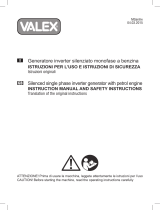 Valex 1371818 Manuale del proprietario
Valex 1371818 Manuale del proprietario
-
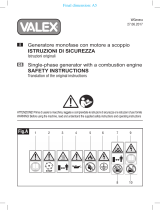 Valex 1371615 Manuale del proprietario
Valex 1371615 Manuale del proprietario
-
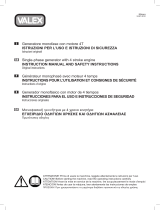 Valex 1371704 Manuale del proprietario
Valex 1371704 Manuale del proprietario
-
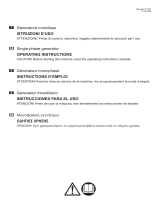 Valex 1371762 Manuale del proprietario
Valex 1371762 Manuale del proprietario
-
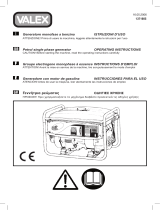 Valex 1371605 Manuale del proprietario
Valex 1371605 Manuale del proprietario
-
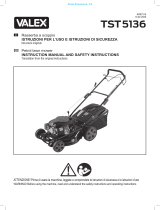 Valex 1497516 Manuale del proprietario
Valex 1497516 Manuale del proprietario
-
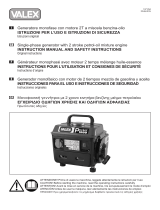 Valex 1371764 Manuale del proprietario
Valex 1371764 Manuale del proprietario
-
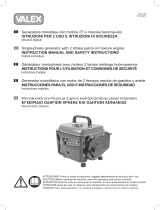 Valex 1371765 Manuale del proprietario
Valex 1371765 Manuale del proprietario















